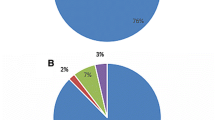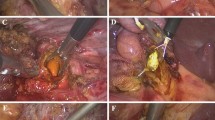Abstract
Background
Previous upper abdominal surgery (PUAS) is considered a contraindication to laparoscopic surgery. Whether LCBDE-PC is feasible and beneficial for patients with PUAS remains unclear. This study aimed to evaluate the feasibility and benefits of LCBDE-PC for patients with PUAS.
Methods
From June 2011 to September 2019, 1167 patients who underwent laparoscopic procedures for choledocholithiasis were reviewed retrospectively. Perioperative outcomes were compared between patients with and without PUAS in un-matched and matched cohorts.
Results
LCBDE-PC was performed successfully in 88.3% of patients with PUAS, and 92.5% of patients without PUAS (P > 0.05). Multivariate analysis showed that PUAS was not a risk factor that affected successful performance of LCBDE-PC. Although a higher rate of conversion to open surgery and longer operative time were observed in patients with PUAS, no significant differences were found between patients with and without PUAS in multivariate and propensity score analysis (P > 0.05). A predictive nomogram for LCBDE-PC failure was developed based on potential predictors from the least absolute shrinkage and selection operator (LASSO) regression model. Successful performance of LCBDE-PC was associated with operative time. A linear regression model for operative time showed impacted stone in the CBD and intraoperative laser use was the most important factor in determining the operative time.
Conclusion
LCBDE-PC is feasible and beneficial for patients with PUAS. However, patients with PUAS with a high possibility of LCBDE-PC failure from the nomogram and a longer operative time from the linear regression model should be cautious when undergoing LCBDE-PC.




Similar content being viewed by others
Abbreviations
- CBD:
-
Common bile duct
- LCBDE:
-
Laparoscopic common bile duct exploration
- PC:
-
Primary closure
- LCBDE-PC:
-
Laparoscopic common bile duct exploration with primary closure
- LCBDE-T:
-
Laparoscopic common bile duct exploration with T tube drainage
- LC:
-
Laparoscopic cholecystectomy
- OCBDE:
-
Open common bile duct exploration
- OCBDE-PC:
-
Open common bile duct exploration with primary closure
- OCBDE-T:
-
Open common bile duct exploration with T tube drainage
- PS:
-
Propensity score
- PUAS:
-
Previous upper abdominal surgery
- PLAS:
-
Previous lower abdominal surgery
- ERCP:
-
Endoscopic retrograde cholangiopancreatography
- EST:
-
Endoscopic sphincterotomy
- CI:
-
Confidence interval
- OR:
-
Odds ratio
- MD:
-
Mean difference
References
Gurusamy KS, Davidson BR (2014) Gallstones. BMJ 348:g2669
Nzenza TC, Al-Habbal Y, Guerra GR, Manolas S, Yong T, McQuillan T (2018) Recurrent common bile duct stones as a late complication of endoscopic sphincterotomy. BMC Gastroenterol. 18
Yoo ES, Yoo BM, Kim JH et al (2018) Evaluation of risk factors for recurrent primary common bile duct stone in patients with cholecystectomy. Scand J Gastroenterol 53(4):466–470
Costantini R, Caldaralo F, Palmieri C et al (2012) Risk factors for conversion of laparoscopic cholecystectomy. Ann Ital Chir 83(3):245–252
Williams E, Beckingham I, El Sayed G et al (2017) Updated guideline on the management of common bile duct stones (CBDS). Gut 66(5):765–782
Zhu HY, Xu M, Shen HJ et al (2015) A meta-analysis of single-stage versus two-stage management for concomitant gallstones and common bile duct stones. Clin Res Hepatol Gastroenterol 39(5):584–593
Gholipour C, Shalchi RA, Abassi M (2007) Efficacy and safety of early laparoscopic common bile duct exploration as primary procedure in acute cholangitis caused by common bile duct stones. J Laparoendosc Adv Surg Tech A 17(5):634–638
Mattila A, Mrena J, Kellokumpu I (2017) Cost-analysis and effectiveness of one-stage laparoscopic versus two-stage endolaparoscopic management of cholecystocholedocholithiasis: a retrospective cohort study. BMC Surgery 17(1):79
Zhang HW, Chen YJ, Wu CH, Li WD (2014) Laparoscopic common bile duct exploration with primary closure for management of choledocholithiasis: a retrospective analysis and comparison with conventional T-tube drainage. Am Surg 80(2):178–181
Podda M, Polignano FM, Luhmann A, Wilson MS, Kulli C, Tait IS (2016) Systematic review with meta-analysis of studies comparing primary duct closure and T-tube drainage after laparoscopic common bile duct exploration for choledocholithiasis. Surg Endosc 30(3):845–861
Pan L, Chen MY, Ji L et al (2018) The safety and efficacy of laparoscopic common bile duct exploration combined with cholecystectomy for the management of cholecysto-choledocholithiasis an up-to-date meta-analysis. Ann Surg 268(2):247–253
Prasson P, Bai XL, Zhang Q, Liang TB (2016) One-stage laproendoscopic procedure versus two-stage procedure in the management for gallstone disease and biliary duct calculi: a systemic review and meta-analysis. Surg Endosc Other Intervent Tech 30(8):3582–3590
Yun KW, Ahn YJ, Lee HW et al (2012) Laparoscopic common bile duct exploration in patients with previous upper abdominal operations. Korean J Hepato-Biliary-Pancreatic Surgery 16(4):154–159
Zhang K, Zhan F, Zhang Y et al (2016) primary closure following laparoscopic common bile duct reexploration for the patients who underwent prior biliary operation. Surg Endosc 78(5):364–370
Zheng C, Huang Y, Xie E, Xie D, Peng Y, Wang X (2017) Laparoscopic common bile duct exploration: a safe and definitive treatment for elderly patients. Surg Endosc 31(6):2541–2547
Hua J, Meng H, Yao L, et al. (2016) Five hundred consecutive laparoscopic common bile duct explorations: 5-year experience at a single institution. Surg Endosc
Burkhart RA, Relles D, Pineda DM et al (2013) Defining treatment and outcomes of hepaticojejunostomy failure following pancreaticoduodenectomy. J Gastrointest Surgery 17(3):451–460
Sagara Y, Freedman RA, Vaz-Luis I et al (2016) Patient prognostic score and associations with survival improvement offered by radiotherapy after breast-conserving surgery for ductal carcinoma in situ: a population-based longitudinal cohort study. J Clin Oncol 34(11):1190–1196
Hua J, Lin S, Qian D, He Z, Zhang T, Song Z (2015) Primary closure and rate of bile leak following laparoscopic common bile duct exploration via choledochotomy. Digest Surg 32(1):1–8
Hua J, Meng HB, Yao L et al (2017) Five hundred consecutive laparoscopic common bile duct explorations: 5-year experience at a single institution. Surg Endosc Other Intervent Tech 31(9):3581–3589
Darkahi B, Liljeholm H, Sandblom G (2016) Laparoscopic common bile duct exploration: 9 years experience from a single center. Front Surgery 3:23
Decker G, Borie F, Millat B et al (2003) One hundred laparoscopic choledochotomies with primary closure of the common bile duct. Surg Endosc 17(1):12–18
Yi HJ, Hong G, Min SK, Lee HK (2015) Long-term outcome of primary closure after laparoscopic common bile duct exploration combined with choledochoscopy. Surg Laparosc Endosc Percutaneous Tech 25(3):250–253
Zhang WJ, Xu GF, Wu GZ, Li JM, Dong ZT, Mo XD (2009) Laparoscopic exploration of common bile duct with primary closure versus T-tube drainage: a randomized clinical trial. J Surg Res 157(1):e1-5
Jameel M, Darmas B, Baker AL (2008) Trend towards primary closure following laparoscopic exploration of the common bile duct. Ann R Coll Surg Engl 90(1):29–35
Lee W, Kwon J (2013) Ten-year experience on common bile duct exploration without T-tube insertion. Korean J Hepato-biliary-pancreatic Surgery 17(2):70–74
Karayiannakis AJ, Polychronidis A, Perente S, Botaitis S, Simopoulos C (2004) Laparoscopic cholecystectomy in patients with previous upper or lower abdominal surgery. Surg Endosc 18(1):97–101
Wu JM, Lin HF, Chen KH, Tseng LM, Tsai MS, Huang SH (2007) Impact of previous abdominal surgery on laparoscopic appendectomy for acute appendicitis. Surg Endosc 21(4):570–573
Tokunaga M, Hiki N, Fukunaga T, Nunobe S, Ohyama S, Yamaguchi T (2010) Laparoscopy-assisted gastrectomy for patients with earlier upper abdominal open surgery. Surg Laparosc Endosc Percutaneous Tech 20(1):16–19
Diez J, Delbene R, Ferreres A (1998) The feasibility of laparoscopic cholecystectomy in patients with previous abdominal surgery. HPB Surg 10(6):353–356
Ahn KS, Han HS, Yoon YS, Cho JY, Kim JH (2011) Laparoscopic liver resection in patients with a history of upper abdominal surgery. World J Surg 35(6):1333–1339
Law WL, Lee YM, Chu KW (2005) Previous abdominal operations do not affect the outcomes of laparoscopic colorectal surgery. Surgical Endosc Other Intervent Tech 19(3):326–330
Lee A, Min SK, Park JJ, Lee HK (2011) Laparoscopic common bile duct exploration for elderly patients: as a first treatment strategy for common bile duct stones. J Korean Surg Soc 81(2):128–133
Akyurek N, Salman B, Irkorucu O et al (2005) Laparoscopic cholecystectomy in patients with previous abdominal surgery. JSLS 9(2):178–183
Acknowledgements
This work was supported by Natural Science Foundation of Shanghai (18ZR1429600).
Author information
Authors and Affiliations
Corresponding authors
Ethics declarations
Disclosures
Bin Xu, Tingyi Luo, Tingsong Yang, Shilin Wang, Hongbo Meng, Jian Gong, Bo Zhou, Wenyan Zheng, and Zhenshun Song have no conflicts of interest to disclose.
Additional information
Publisher's Note
Springer Nature remains neutral with regard to jurisdictional claims in published maps and institutional affiliations.
Supplementary Information
Below is the link to the electronic supplementary material.
Rights and permissions
About this article
Cite this article
Xu, B., Luo, T., Yang, T. et al. Laparoscopic common bile duct exploration with primary closure is beneficial for patients with previous upper abdominal surgery. Surg Endosc 36, 1053–1063 (2022). https://doi.org/10.1007/s00464-021-08371-8
Received:
Accepted:
Published:
Issue Date:
DOI: https://doi.org/10.1007/s00464-021-08371-8




